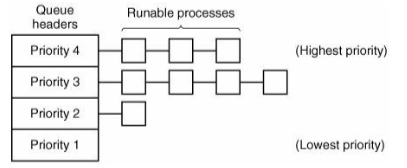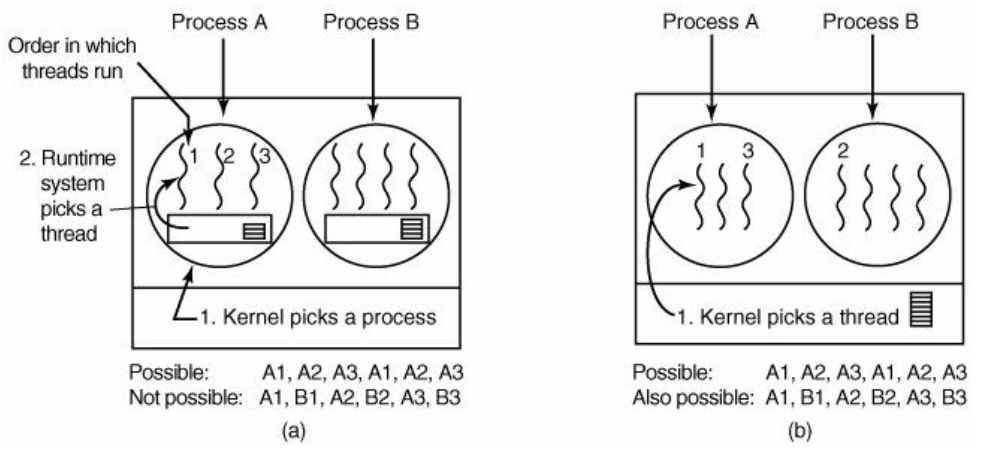Operating Systems
Table of Contents
Scheduling
 if more processes ready than CPUs available:
if more processes ready than CPUs available:
- scheduler decides which process to run next
- algorithm used by scheduler is called scheduling algorithm
when to schedule?
- process exits
- process blocks on IO or semaphore
- when new process is created
- when IO interrupt occurs
- when clock interrupt occurs
scheduling #goals
- different goals for batch, interactive, or real time systems
- for all systems:
- fairness: giving each process a fair share of CPU
- policy reinforcement: carrying out stated policy
- balance: keeping all parts of system busy
- throughput: maximise jobs per hour
- turaround time: minimise time between submission and termination
- CPU utilisation: keepin CPU busy all the time
Batch scheduling algorithms:
- First-Come First-Served (FIFO)
- process jobs in order of arrival
- non-preemptive
- single process Q:
- new jobs or blocking processes are added to end of Q
- can lead to “convoy effect” if only few CPU bound and many IO bound processes
- Shortest job first:
- pick job with the shortest run time
- provably optimal: lowest turnaround time
- of course, runtimes have to be known in advance
- may lead to starvation, if a lot of short-lived processes arrive then a long run-time process will never run
- highest-response-ratio-next – improved version of shortestjob first
Interactive scheduling:
- response time – respond to requests quickly
- proportionality – meet users’ expectations
- algorithms:
- round robin scheduling:
- preemptive algorithm
- each process gets a time slice (quantum)
- if process is still running at end of quantum, it gets preemted & goes to end of ready Q
- how big should that quantum be? depends on the implementation (lol when does it not depend)
- of course, you don’t want most of the time to be context switching
- priority scheduling
- similar to round robin, but several ready Qs

- next process is picked from Q with highest priority
- static vs dynamic
- static priority: there is a single unchanging priority. often used as base priority level.
- dynamic priority: OS cleverly decides which processes should have higher priorities (e.g. if IO bound, should have higher priority than CPU bound)
- but can lead to priority inversion (e.g. Pathfinder). solutions:
- priority ceiling protocol: mutex gets priority assigned of the highest priority process that might lock the mutext
- priority inheritance protocol: high priority process blocks because low priority process hold mutex -> low priority process ‘inherits’ priority of blocked process
- random boosting: ready processes holding mutexes are temporarily (and randomly) boosted in priorities
- how to minimise response time for each priority Q? shortest process next:
- use shortest job first and try to best predict next running time
- form weighted average of previous running times of processes
- guaranteed scheduling
- N processes running -> each process gets 1/Nth of CPU time (aka fair-share)
- calc how much CPU time process might have gotten (time since process creation divided by N)
- measure actual consumed CPU time
- form ratio (e.g. 0.5 means process running for half the time it was entitled to)
- pick process with smallest ratio to run next
- lottery scheduling
- processes get lottery tickets
- whenever scheduling decision has to be made, OS chooses winning ticket randomly
- processes can have multiple tickets & priorities
- tickets can be traded between processes
- round robin scheduling:
real time systems
- main concerns:
- meeting deadlines - avoid using data
- predictability - avoid quality degradation in multimedia systems
- soft real time vs hard real time (cannot miss any deadlines)
- can consist of periodic and aperiodic tasks
- schedules can be static (schedules are known in advance) or dynamic (make scheduling decisions during execution)
- system with periodic tasks is schedulable when we can meet the deadlines
